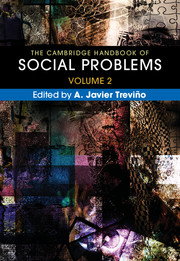Book contents
- The Cambridge Handbook of Social Problems
- The Cambridge Handbook of Social Problems
- Copyright page
- Contents
- About the Contributors
- Introduction
- Part I Problems Related to Health, Safety, and Security
- Chapter 1 Illness and Health Care
- Chapter 2 Mental Illness and Social Problems
- Chapter 3 Substance Abuse
- Chapter 4 Epidemics, Pandemics, and Outbreaks
- Chapter 5 Disaster as Social Problem and Social Construct
- Chapter 6 Surveillance
- Chapter 7 Domestic Spying: A Historical-Comparative Perspective
- Chapter 8 Computer Hacking as a Social Problem
- Chapter 9 War and Militarism
- Chapter 10 The Social Problem of Terrorism
- Chapter 11 Genocide
- Part II Problems Related to Crime and Violence
- Part III Problems of Global Impact
- Index
- References
Chapter 10 - The Social Problem of Terrorism
from Part I - Problems Related to Health, Safety, and Security
Published online by Cambridge University Press: 16 March 2018
- The Cambridge Handbook of Social Problems
- The Cambridge Handbook of Social Problems
- Copyright page
- Contents
- About the Contributors
- Introduction
- Part I Problems Related to Health, Safety, and Security
- Chapter 1 Illness and Health Care
- Chapter 2 Mental Illness and Social Problems
- Chapter 3 Substance Abuse
- Chapter 4 Epidemics, Pandemics, and Outbreaks
- Chapter 5 Disaster as Social Problem and Social Construct
- Chapter 6 Surveillance
- Chapter 7 Domestic Spying: A Historical-Comparative Perspective
- Chapter 8 Computer Hacking as a Social Problem
- Chapter 9 War and Militarism
- Chapter 10 The Social Problem of Terrorism
- Chapter 11 Genocide
- Part II Problems Related to Crime and Violence
- Part III Problems of Global Impact
- Index
- References
Summary
Following the political examination of terrorism, this chapter suggests that the social problem task is not to expose or define the terrorist of the week – be it the Unabomber or the Islamic State organization (ISIS) threatening national security or the Central Intelligence Agency conducting covert actions – but to examine the political processes and practices that maintain, create, and change the definitions of certain actions as terrorist. Accordingly, we may be better able to understand the status of terrorism as either an act of defiance, deviance, social control, politics, and/or coercion and to understand it as part of a particular time and place.
- Type
- Chapter
- Information
- The Cambridge Handbook of Social Problems , pp. 155 - 172Publisher: Cambridge University PressPrint publication year: 2018



